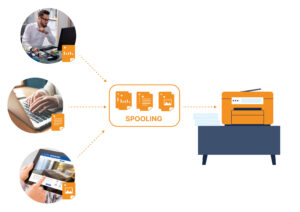Why is ThinPrint 11 a Superior High Availability Printing Solution for Windows Server 2016?
At the end of September 2016 the first finished build of Windows Server 2016 is due to be launched. This will take place at the Microsoft Ignite conference in Atlanta, Georgia, USA as the two year Technical Preview period draws to a close.

ThinPrint 11 ensures High Availability for printing.
What’s new in Windows Server 2016?
Windows Server 2016 will contain a great many new security and advanced technical improvements, leading on from Windows Server 2012 and 2008. This product update will include dedicated features such as Nano Server functionality and encrypted, shielded virtual machines.
Of particular focus are the virtual machine optimisations that have been made for business environments requiring high availability when it comes to digital resources. Microsoft has heavily implied that both the Standard and Datacenter editions of 2016 will be better optimised for organisations that require mass, high speed, constant access to shared resources (such as cluster hosted data and mass print spooling) than ever before.
However, there is one potential technical drawback to 2016 that has caused deep controversy. Microsoft has also confirmed that all versions of 2016 will continue to provide 2012’s Hyper-V clustered “HA Printing” function as a virtualized dual node failover solution when it comes to supporting dedicated servers for high availability networked printing.
Support for traditional physical server failover solutions or dual printserver clustering will remain discontinued, as they have been since Microsoft’s 2012 release. This is in sharp contrast to Microsoft’s planned file server failover strategy, which will allow traditional dual node clustering as out of the box functionality. A rollback to Windows Server 2008 R2 or earlier will be required to continue using a networked Windows printing cluster with two or more servers.
What does this all mean for print servers?
The most important point is that an upgrade to 2016 essentially forces administrators to virtualize their printserver(s) across two or more node machines to use a failover solution without any additional third-party support. While a single dedicated physical server is still feasible, any failure whatsoever could mean a complete printer system crash.
A second node must be configured as a redundant system to simultaneously run Windows Server 2016 Hyper-V. Node 2 (and any others) will automatically take over virtual machine runtime from Node 1 to handle printing in the event of hardware or software failure and OS maintenance through migration. This can be done via automatic detection or a manual order from the administrator. During runtime, all pointed networked print traffic is subsequently directed to one central print server on one virtual machine on one active node.
Strengths and Weaknesses of Hyper-V in this context
This sort of networked print server virtualization does have some advantages. It makes better use of the improved speed and memory capacity of modern systems through streamlining. It also allows traditional mission critical installations to be run and monitored simultaneously on one node machine whilst being backed up together automatically on others. It can also reduce the need for manual server backups and complex, shared print driver cluster certification modifications on large networks, if used correctly.
However, it is arguable that this print virtualization strategy contains some serious oversights and unreasonable assumptions as to software stability. The entire virtualized print cluster can be disabled through a single, common minor software fault in the main virtual machine, such as an incorrectly installed driver crashing the spooler. Switching does not help. These faults are unfortunately replicated to the backup node(s) instantly due to the inherent way Hyper-V operates in rapidly migrating your virtual print server back and forth.
While reboots and spooler restarts may provide a temporary fix, chronic problems can result without a reasonable amount of unplanned system downtime for IT support to provide maintenance or rollbacks. Downtime is also a mandatory requirement for any virtual machine OS updates, disabling print functionality for relatively long periods. Worse, a corrupt virtual installation or patching problems can mean the lost productivity of a complete system rollback with no feasible replacement servers.
Client routing problems due to inconsistent naming conventions have also been highlighted as a common network headache when it comes to migrating virtual machines.
Why is ThinPrint 11 a Better Solution to These Problems?
ThinPrint 11 does away with these problems through providing both traditional server clustering and dynamic resource allocation, enhancing network-wide productivity and shrinking print waiting times through true high availability. ThinPrint is fully compatible with all recent Windows Servers.
ThinPrint provides network access to clustered groups of virtual or physical Windows print servers in tandem, rather than just as backup virtual machine hosts. If one server has to be taken offline, the others will take over the excess tasks instantly if they have ThinPrint installed. This allows for easy, continuous use of the same printer mapping amongst clients and better network resilience. ThinPrint also has an inbuilt maintenance mode that allows for rapid, pain-free connection and disconnection of problematic machines.
In addition to this, ThinPrint allows for better server load balancing and more rapid printing through dynamic traffic management. The Printer Self Service feature and group policy functions also allow for a reduction in pressure on IT support, automating basic configuration tasks and providing an enhanced end user experience.
See what ThinPrint 11 can do for your network.




